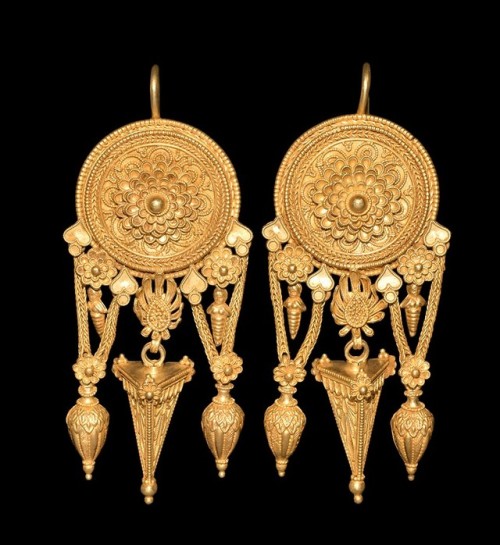#bee goddess
Post link
Greek Gold Earrings with Goddess Motifs, 4th Century BC
A pair of gold earrings with central shield decorated with bead wire to the edges; within each shield a series of loops bordered by bead wire; to the center a rosette consisting of four layers of petals with concave centers and with bead wire edges, with central bead; to the edge of each shield a series of heart-shaped leaves and two layer rosettes with acanthus leaf ornament to the center; from each smaller rosette a miniature figure of a goddess with hands to breasts and wearing a sheath dress; from the central acanthus leaf is an inverted pyramid pendant with miniature rosettes to each corner and bead wire edge with loops below; to each face of the pyramid a palmette motif in bead wire; granule beads to the base of each pyramid; from each of the heart-shaped leaves on the shield a loop in loop chain joined at the bottom by a rosette from which hangs a ribbed seed-like pendant; wire loop to the back. 29.93 grams total, 65mm (2 ½")
Disc and pyramid earrings are widely found throughout the Greek world: in addition to the East Greek examples, they have been discovered in the North Pontic region, on Cyprus, in Greece and in South Italy. The East Greek jewelers seem to have been particularly fond of pendants in the form of Nikai, Erotes and female figures.
The small pendant images on this earring bear similarities to motifs associated with the so called ‘bee goddess’ that was popular in Asia Minor and referred to as “The Pure Mother Bee” in ancient Greece. Honey was regarded as an elixir in Mediterranean societies; a magic potion that ensured a long and healthy life. In addition to being an elixir, honey was a healing substance with a variety of medicinal uses due to its antiseptic qualities.
Post link


